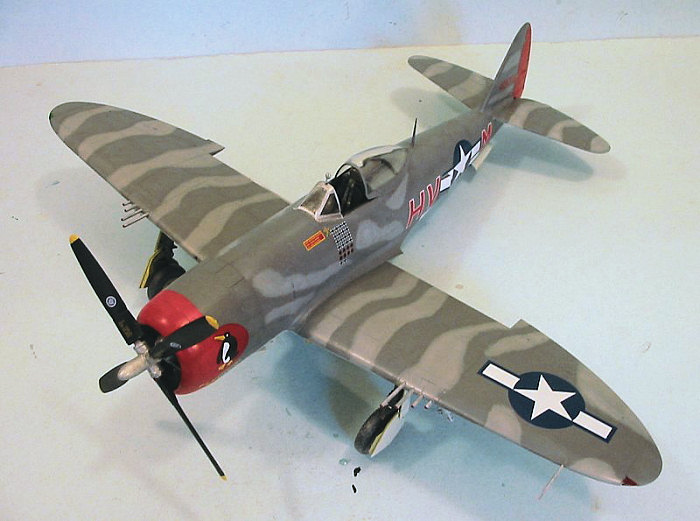
Hasegawa 1/32 P-47D Thunderbolt
| KIT #: | 08077 |
| PRICE: | 5200 yen |
| DECALS: | Two Options |
| REVIEWER: | Tom Cleaver |
| NOTES: | new mold |

| HISTORY |
Famed Grumman test pilot Corky Meyer - the last actual "airplane person" to head a major airplane company - named the P-47 Thunderbolt the "best fighter of World War II - ETO." As he pointed out, it had high performance, yet a wartime-trained 200-hour pilot could fly it, with a well laid-out cockpit in which all the controls, switches, and instruments were handily located. It exceeded at three of the four performance parameters he established: air combat capability, fighter escort capability, ground support capability and photo-reconnaissance (it only missed on the latter). With 15,683 Thunderbolts produced between 1941-45, it is the most-produced American fighter ever. Republic delivered one in 1941, 532 in 1942, 4,428 in 1943, 7,065 in 1944 and 3,657 in 1945. 730 were operated by the RAF in Southeast Asia, while 446 flew for the French Air Force in Europe. The only theater of war in which the Thunderbolt did not fight was in Alaska; it is telling that the two top-scoring American fighter pilots in the ETO both flew P-47s exclusively, and all 10 of the top P-47 aces in the ETO survived the war. By D-Day there were 17 P-47 Fighter Groups stationed in England, and in the next eleven months, they swept across western Europe like an aerial scythe.
The P-47 Thunderbolt acquired its name "Jug" when the P-47D-25 series appeared on operations. With the upper fuselage cut down to make way for a teardrop-shaped "bubbletop" canopy, the fuselage took on the shape of a milk bottle, hence "Jug." It was later claimed the name came from the word "Juggernaut," and in light of the career of the bubbletop Thunderbolts across Western Europe in the period between D-Day and V-E Day, that sounds reasonable. But to Thunderbolt pilots who were there when the "bubbletop" replaced the "razorback," "Jug" meant milk jug.
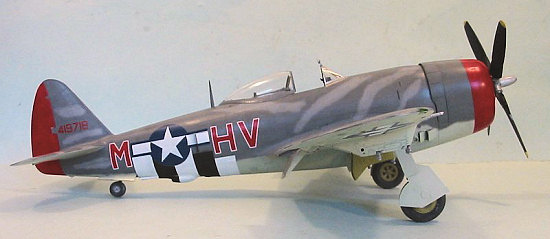 The first "bubbletop"
Thunderbolt was the YP-47K, which began life as a P-47D-11RE, and was the second
fighter fitted with a "bubble" canopy after the British Hawker Typhoon.
Originally scheduled for production as the P-47L, the "super 'Bolt" as pilots
called it originally began appearing in England in May, 1944, under the
designation P-47D-25RE. With an R-2800-59 or -63 engine putting out 2,300 h.p.
under war emergency rating, and swinging a Hamilton Standard Hydromatic
propeller of 13 feet, 1 7/8 inches diameter, the airplane had increased tankage
and the ability to carry a 150-gallon drop tank on the centerline shackles. At
first, only flight leaders - group commanders and squadron commanders - received
the new airplane. By the end of the summer of 1944, with the high losses
sustained in ground attack missions during the Battle of Normandy, the
"bubbletop" P-47D-25, -26, -27 and -28 Thunderbolts from Farmingdale (RE) and
Evansville (RA) were the standard fighter bomber of the U.S. 9th Army Air Force.
The first "bubbletop"
Thunderbolt was the YP-47K, which began life as a P-47D-11RE, and was the second
fighter fitted with a "bubble" canopy after the British Hawker Typhoon.
Originally scheduled for production as the P-47L, the "super 'Bolt" as pilots
called it originally began appearing in England in May, 1944, under the
designation P-47D-25RE. With an R-2800-59 or -63 engine putting out 2,300 h.p.
under war emergency rating, and swinging a Hamilton Standard Hydromatic
propeller of 13 feet, 1 7/8 inches diameter, the airplane had increased tankage
and the ability to carry a 150-gallon drop tank on the centerline shackles. At
first, only flight leaders - group commanders and squadron commanders - received
the new airplane. By the end of the summer of 1944, with the high losses
sustained in ground attack missions during the Battle of Normandy, the
"bubbletop" P-47D-25, -26, -27 and -28 Thunderbolts from Farmingdale (RE) and
Evansville (RA) were the standard fighter bomber of the U.S. 9th Army Air Force.
Boleslaw “Mike” Gladych:
Aviation has always attracted “larger than life” personalities, and this has always been particularly so during wars. Among the most interesting “larger than life” pilots to fly during the Second World War was Boleslaw “Mike” Gladych, whose wartime exploits have, over the years since, become merged with romance, hearsay, rumor and embellishment, obscuring his very real achievements. His wartime score is reported as 17 claimed destroyed, 2 probables, 1 shared damaged, and 5 ground kills, all achieved while flying with the RAAF and the RAF, which makes him the only leading Polish ace who never flew in the Polish Air Force. While the U.S. Air Force recognizes his ten victories claimed while flying with the 56th Fighter Group, these are not officially recognized by the Polish Air Force, due to the “irregular” manner with which he and the other Poles attached themselves to Francis Gabreski’s 61st Fighter Squadron in 1944. It is also rumored that he deliberately under-claimed so that he would avoid promotion and could continue flying combat.
Gladych graduated at the top of his class from the Polish Air Force Academy and was commissioned on September 1, 1939, too late to see active service. Toward the end of the Polish campaign, he led a group of newly commissioned pilots who flew PZL P.7 fighters of the Polish Pilot's School to Romania, where he was interned by the Romanian government. Escaping from the n internment camp that December - and reportedly killing a guard in the process - he reached France in the spring of 1940 and joined the recently formed Polish-manned "Finnish" Squadron, which just missed being sent to fly in the Winter War. The unit then became an Armee de l'Air Polish volunteer unit- Groupe de Chasse I/145, and was equipped with the experimental Caudron C.R.714 lightweight fighter.
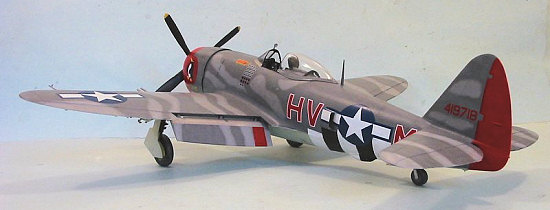 Gladych claimed victories
during the Blitzkrieg, but these were never confirmed officially, probably due
to the confusion of battle. With other Polish veterans of the French campaign,
Gladych managed to get to Britain following the French surrender, and was
eventually sent to 303 (Polish) Squadron in October 1940. His first claims with
the RAF were not made until June 23, 1941, when he claimed 3 Bf 109's shot down
and a probable in 2 sorties. Following the second fight he crash landed at
Manston, receiving some severe injuries that hospitalized him until October. In
1942 he transferred to 302 “City of Poznan” Squadron, where he was promoted to
Flight Lieutenant and served as Flight Commander.
Gladych claimed victories
during the Blitzkrieg, but these were never confirmed officially, probably due
to the confusion of battle. With other Polish veterans of the French campaign,
Gladych managed to get to Britain following the French surrender, and was
eventually sent to 303 (Polish) Squadron in October 1940. His first claims with
the RAF were not made until June 23, 1941, when he claimed 3 Bf 109's shot down
and a probable in 2 sorties. Following the second fight he crash landed at
Manston, receiving some severe injuries that hospitalized him until October. In
1942 he transferred to 302 “City of Poznan” Squadron, where he was promoted to
Flight Lieutenant and served as Flight Commander.
With his second RAF tour completed in January 1944, and credited with seven air victories, Gladych was in no mood for a ground assignment. He and Flight Lieutenant Witold Lanowski turned the friendship they had made with Major Francis Gabreski during his service with the Polish Wing in the summer and fall of 1942 into an opportunity to serve in the 61st Fighter Squadron of the 56th Fighter Group. Officially, Gladych was assigned to organize air combat training for replacement pilots, but he managed to fly combat missions. His first score with the 56th was two Bf-109s shot down on February 21, 1944.
In June, 1944, by which time he had scored another eight victories, the Polish Air Force discovered Gladych, Lanowski, and four other Polish pilots had “slipped the bounds” and were flying combat with the Americans. The Polish authorities threatened to expel all of them from the Polish Air Force, and four of the pilots did quit the 56th. Gladych and Lanowski continued and were expelled. Between June and October 1944, neither man was officially in anybody’s armed forces! The Polish government relented in October and restored them to membership in the Air Force. The result of this is that the Polish Air Force does not recognize Gladych’s ten aerial and five ground claims with the 56th FG, though the USAF does. During his time in the 56th, Gladych was unofficially carried as a “Major,” the equivalent of his RAF rank of Squadron Leader. All the P-47s he flew in the 56th were named Pengie, the nickname of his Canadian WAAF girlfriend, which continued to Pengie V as he received newer aircraft. His insignia was the cartoon image of a penguin on the left side of the engine cowling.
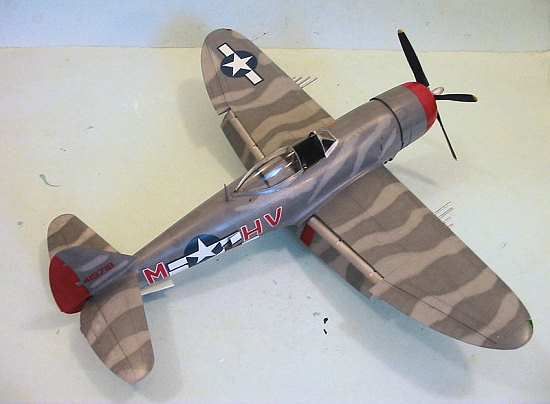 While Gladych served with
the 56th to the end of the war, it is also rumored that he went off
and flew with an un-named P-51 group during the period when the 56th
was having difficulty with their new P-47Ms and shot down an Me-262, though this
has never been verified.
While Gladych served with
the 56th to the end of the war, it is also rumored that he went off
and flew with an un-named P-51 group during the period when the 56th
was having difficulty with their new P-47Ms and shot down an Me-262, though this
has never been verified.
Gladych was summarily dismissed from service with the USAAF following the end of the war, but not before he used his unofficial “USAAF” status to rescue his brother, a Polish resistance fighter, from a Soviet POW camp. During the war, Gladych was awarded the Virtuti Militari, (Cross of Valor) with three bars by the Polish Air Force, the Distinguished Flying Cross by the RAF, and the Silver Star with two clusters, and the Air Medal with three clusters by the USAAF.
In the early 1950s, Gladych emigrated to the United States and settled in Seattle, Washington, where he married “Pengie” and returned to school where he gained a Ph.D. in psychiatry. A friend of the legendary Gil Robb Wilson, then editor of “Flying” Magazine, he wrote about his adventures in the magazine during the 1950s, which is where this then-young avid reader of all things “airplane” first ran across his name.
During the 1980s, Gladych, a well-known psychotherapist, became a Buddhist and embraced the philosophy of nonviolence, giving up all contact with his wartime comrades. As of 2005, he and his wife, Elizabeth, still live in Seattle.
| THE KIT |
The first injection-molded 1/32 P-47d was released by Revell 30 years ago. As with many kits from that era, it suffered from various inaccuracies, several of which - like the incorrectly-shaped vertical fin and rudder - were not fixable. While Jerry Rutman released an accurate 1/32 P-47D in resin during the 1990s, until the arrival of this kit from Hasegawa, that Revell kit was it for mainstream modeling.
This Hasegawa kit effectively makes the Revell kit irrelevant. When this kit was announced, many modelers were afraid that Hasegawa would merely scale up their 1/48 kit, which suffered from its own unfixably-wrong errors. There is no need to worry. This kit is far closer to being a 1/32 scale-up of the highly-accurate Tamiya P-47D than to anything else from Hasegawa.
 Out of the box, the kit
makes up most accurately as a P-47D-27 or later Thunderbolt, due to the fact
that the cockpit provides only the smooth floor associated with later
Thunderbolts. The kit provides both the hydraulic Hamilton-Standard prop used
by the P-47D-25/26 and the Curtiss-Electric symmetrical paddle prop used by the
P-47D-27 and later. If a modeler elects to use the later gunsight and the
extended vertical fin part that are both provided but listed as “not to be
used,” the kit can be turned into any bubbletop P-47D up to the P-47D-40. A
modeler who obtains Jerry Rutman’s resin asymmetrical prop, it will be possible
to construct a P-47M.
Out of the box, the kit
makes up most accurately as a P-47D-27 or later Thunderbolt, due to the fact
that the cockpit provides only the smooth floor associated with later
Thunderbolts. The kit provides both the hydraulic Hamilton-Standard prop used
by the P-47D-25/26 and the Curtiss-Electric symmetrical paddle prop used by the
P-47D-27 and later. If a modeler elects to use the later gunsight and the
extended vertical fin part that are both provided but listed as “not to be
used,” the kit can be turned into any bubbletop P-47D up to the P-47D-40. A
modeler who obtains Jerry Rutman’s resin asymmetrical prop, it will be possible
to construct a P-47M.
The kit has separate flaps, which can be posed up or down. In my experience, posable flaps are best displayed down, since fit to the wing can be problematic.
Hasegawa dealt with the problem of having release pin molds inside the gear doors by the very nice expedient of having the gear doors come in inner and outer parts, with the release marks on the inside of both parts.
The wing pylons are separate. Surprisingly, the kit does not provide the more common (at least in the ETO) 108-gallon paper tanks, but does provide the 150-gallon “flat tank” for the centerline and the later “P-38 style” tanks used outside the ETO. Underwing armament also includes two 500-lob bombs.
A very well-molded pilot figure is provided, whose face looks strikingly like Gabreski’s.
The only complaint I can find about the kit overall is that there are several long sink marks on the upper and lower wing halves, where there is internal detail. This is similar to what one finds on the 1/32 Bf-109 wings and Fw-190 wings, and is easily dealt with using Mr. Surfacer 500 and a few minutes with a sanding stick. Polish will have to be applied if a natural metal surface is going to be created.
The decals provide markings for Gabreski’s last and most famous camouflaged P-47D, and for the well-known “Eagle” flown by Glenn Eagleston, with a natural metal finish. As I look at the decals, it appears Hasegawa may have misunderstood various of the “steps of the cross” that occurred with Gabreski’s markings. A modeler who chooses to do this airplane will be well-advised to read Floyd Werner’s analysis of how he marked his two Gabreski ‘Bolts over at HyperScale.
| CONSTRUCTION |
 As with all the new
Hasegawa 1/32 kits, the Thunderbolt is very well-designed and a breeze to
build. That is, it’s a breeze to build if you recognize at the outset that the
parts fit very precisely. If you are particularly careful to cut off all
vestiges of any sprue gates, and test fit everything, you can assemble this kit
with a minimum of any kind of gap-filler. I only used Mr. Surfacer on the
centerline seam along the lower fuselage and on the upper fuselage behind the
cockpit, and both areas could have been perfectly okay with a light sanding.
As with all the new
Hasegawa 1/32 kits, the Thunderbolt is very well-designed and a breeze to
build. That is, it’s a breeze to build if you recognize at the outset that the
parts fit very precisely. If you are particularly careful to cut off all
vestiges of any sprue gates, and test fit everything, you can assemble this kit
with a minimum of any kind of gap-filler. I only used Mr. Surfacer on the
centerline seam along the lower fuselage and on the upper fuselage behind the
cockpit, and both areas could have been perfectly okay with a light sanding.
I had one area of difficulty, and that was in assembling the engine cowling and then attaching the engine and cowling to the rest of the model with a completely accurate fit. The result for me was a very noticeable “step” on the lower area of the cowling/fuselage joint, that required me to apply putty, and then Mr. Surfacer, to obtain a smooth joint there with the correct profile. I am not at this moment ready to declare that this is a fault of the kit until I make a second one (which is bound to happen). I personally think that the four-part cowling is at least as “fiddly” as the DML Fw-190A cowlings, so there is a lot of opportunity here for “operator error.”
From my experience with the engine and cowling, here is my recommendation of what to do to minimize the likelihood of this happening to you: Assemble the engine and then assemble the four-part cowling around it. Let that set up thoroughly before you very carefully attach the cowling flaps. I recommend the closed flaps since there is nothing to be seen with the flaps open and the open flap part will increase the possibility of misalignment in fitting the sub assembly to the model. Once you have the cowl flaps attached to the cowling, test fit the attachment of this subassembly to the forward fuselage, and be sure to align the cowl flaps correctly to the cowling so there are no “steps”. Once you have that done, hold the cowling pinched so that the flaps attach right until the glue sets. Then glue the joint of the lower cowling to the forward fuselage. If you’ve done it all right, there should be no fit problem.
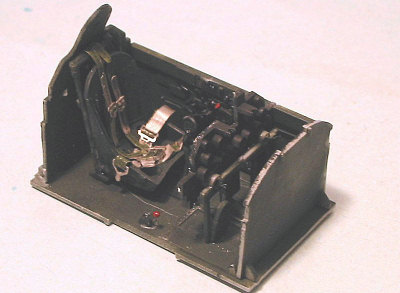 As to the rest of the
construction, I followed the instruction sheet and had no problems. I painted
the cockpit Dull Dark Green (which is not the color the instructions call for,
but is the right color). In my case, I mixed Tamiya “Deep Green” with some
Tamiya “Flat Black” to get the dark green color I saw on the YP-47M restoration
at Yanks Air Museum. Since Yanks is very exact in their restorations and uses
only factory specifications, I trust their work for accuracy. I used the kit
decals for the instrument panel, and finished off by using an Eduard multi-part
seatbelt; this is in my experience, the most accurate seat belt any aftermarket
company has yet created, and it looks just like the WW2 seat belts I have
strapped into out at Chino.
As to the rest of the
construction, I followed the instruction sheet and had no problems. I painted
the cockpit Dull Dark Green (which is not the color the instructions call for,
but is the right color). In my case, I mixed Tamiya “Deep Green” with some
Tamiya “Flat Black” to get the dark green color I saw on the YP-47M restoration
at Yanks Air Museum. Since Yanks is very exact in their restorations and uses
only factory specifications, I trust their work for accuracy. I used the kit
decals for the instrument panel, and finished off by using an Eduard multi-part
seatbelt; this is in my experience, the most accurate seat belt any aftermarket
company has yet created, and it looks just like the WW2 seat belts I have
strapped into out at Chino.
The spars insure that no one is going to misalign the wings on this kit. I had decided to assemble the flaps down, but test-fitting showed that they fit perfectly in the up position. In fact, the P-47 pilot’s notes instructs a pilot to raise the flaps immediately on touchdown, so the accurate way to display the model on the ground is with the flaps up. However, I did this one with the flaps down to show what they look like in the review.
When it comes time to attach the landing gear, the design here is also not going to allow one to misalign the gear, since the tab is set at the correct angles - once in place, the gear is at the correct angles.
Since I was building a P-47D-28RE, I used the gunsight part that is listed in the parts diagram as “do not use.” I also made sure to use the under wing inserts with the dive flaps.
I had painted all the details before assembly, so assembly was quite easy and took only an afternoon. The next day it was time to start painting.
| COLORS & MARKINGS |
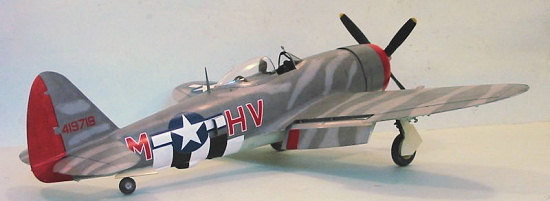 Painting:
Painting:
I had the Techmod decal sheet (thanks to Dr. Charles Metz, who kindly with a sheet from his enormous collection) that has markings for Gladych’s “Pengie IV”, a P-47D-28RE, and “Pengie V,” his well-known P-47M. “Pengie IV” is by far the more colorful airplane, being one that comes from the period when the 56th FG did their own “RAF-style/Luftwaffe-style” camouflage. It is now known these airplanes were all painted with RAF paints. They are particularly interesting because no two were exactly alike.
For a number of years, the “hex-spurtz” have claimed that Gladych’s airplane had the lower surfaces painted “Sky Blue.” Given that the airplane was painted with available RAF paints in England, where the closest equivalent to “Sky blue” - Mediterranean Azure Blue - was likely not available, it is far more likely the airplane was painted “Sky,” which was available. I think the “Sky Blue” comes from that period of time 40 years ago when no one really knew what colors World War II airplanes were painted. As with many other 56th Group P-47s, the upper surfaces were done with two greys, in a style that was reminiscent of both the RAF and the Luftwaffe and was sort of a hybrid of both.
After painting the cowling and rudder white and then Gunze-Sangyo “Red Madder”
and masking them off, I used the new Talon acrylic “Aluminum” for the inner area
of the flaps, and the windscreen. I masked off these areas and then used
Xtracrylix “Sky” for the lower surfaces, and
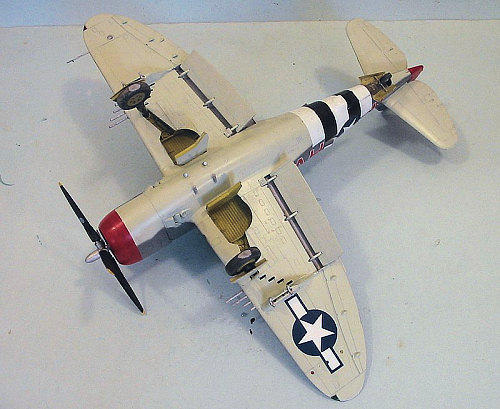 “Dark Sea Grey” and “Medium Sea
Grey” for the upper surfaces. I applied the “Medium Sea Grey” over the whole
surfaces of the wings and horizontal stabilizers, and over the areas where the
blotches were on the fuselage, then applied the Dark Sea Grey over that. When I
unmasked the model, it was indeed as distinctive-looking as I hoped. I gave the
model a coat of Xtracrylix Gloss Varnish and proceeded with the decals.
“Dark Sea Grey” and “Medium Sea
Grey” for the upper surfaces. I applied the “Medium Sea Grey” over the whole
surfaces of the wings and horizontal stabilizers, and over the areas where the
blotches were on the fuselage, then applied the Dark Sea Grey over that. When I
unmasked the model, it was indeed as distinctive-looking as I hoped. I gave the
model a coat of Xtracrylix Gloss Varnish and proceeded with the decals.
Decals:
I decided to use the kit decals for the “D-Day” stripes on the lower fuselage and for the national insignia, because I wanted to see how they worked. These new Hasegawa decals are thinner than the earlier ones and have a real “white” color, which is opaque enough not to allow the colors beneath to bleed through. They go on easily and with a couple of applications of Micro-Sol they snuggle down very nicely.
I used the Techmod decals for the rest of the markings and they presented no difficulties. I decided to forego the stencils because I have yet to see a photo of one of these 56th FG airplanes that were repainted where I can see that the stencils were reapplied. Since they had veteran ground crew, I am sure everyone who serviced these airplanes knew the location and the rules of use of everything on these airplanes.
When the decals were set, I gave the model a coat of Xtracrylix Satin Varnish, to simulate the waxed finish many of these well-maintained airplanes carried.
| FINAL CONSTRUCTION |
I assembled and attached the landing gear, and then the sway braces on the fuselage and the pylons. I had intended to use the 108-gallon tanks I rescued from the Dragon P-51D, but they didn’t fit exactly. The airplane looks good in this clean condition anyway. I attached the blast tubes, and painted the tips red to simulate the tape that went over them for aerodynamic cleanliness before entering combat. The last thing was to attach the prop and the bubble canopy in the open position after. I also cut out the wing tips and used the clear plastic navigation lights.
| CONCLUSIONS |
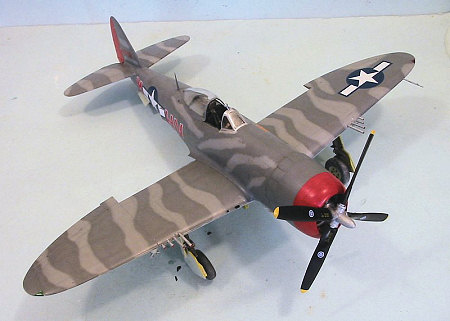 This Thunderbolt from
Hasegawa can join the Tamiya kit as the most accurate P-47 kits available. If I
wasn’t already a fan of 1/32 modeling, this kit would be the “tipping point.”
If you have yet to do a 1/32 model, this is the kit to start with. The
production design is such that it will almost be “foolproof” in assembly as
regards getting the various alignment issues right (I’d almost say “completely
fool-proof,” which I though was the fact with the Bf-109s and the Fw-190s until
I saw the products of a couple of fools at shows, but I’m sure most people will
get it right with this kit). With the likely plethora of aftermarket decal
sheets that will become available in coming months, this should become one of
the most popular 1/32 kits released. It is excellent value for the money and
highly recommended.
This Thunderbolt from
Hasegawa can join the Tamiya kit as the most accurate P-47 kits available. If I
wasn’t already a fan of 1/32 modeling, this kit would be the “tipping point.”
If you have yet to do a 1/32 model, this is the kit to start with. The
production design is such that it will almost be “foolproof” in assembly as
regards getting the various alignment issues right (I’d almost say “completely
fool-proof,” which I though was the fact with the Bf-109s and the Fw-190s until
I saw the products of a couple of fools at shows, but I’m sure most people will
get it right with this kit). With the likely plethora of aftermarket decal
sheets that will become available in coming months, this should become one of
the most popular 1/32 kits released. It is excellent value for the money and
highly recommended.
Copyright ModelingMadness.com. All rights reserved. No reproduction in part or in whole without express permission.
May 2007
If you would like your product reviewed fairly and quickly, please contact the editor or see other details in the Note to Contributors.